The Intel Comet Lake Core i9-10900K, i7-10700K, i5-10600K CPU Review: Skylake We Go Again
by Dr. Ian Cutress on May 20, 2020 9:00 AM EST- Posted in
- CPUs
- Intel
- Skylake
- 14nm
- Z490
- 10th Gen Core
- Comet Lake
CPU Performance: Web and Legacy Tests
While more the focus of low-end and small form factor systems, web-based benchmarks are notoriously difficult to standardize. Modern web browsers are frequently updated, with no recourse to disable those updates, and as such there is difficulty in keeping a common platform. The fast paced nature of browser development means that version numbers (and performance) can change from week to week. Despite this, web tests are often a good measure of user experience: a lot of what most office work is today revolves around web applications, particularly email and office apps, but also interfaces and development environments. Our web tests include some of the industry standard tests, as well as a few popular but older tests.
We have also included our legacy benchmarks in this section, representing a stack of older code for popular benchmarks.
All of our benchmark results can also be found in our benchmark engine, Bench.
Speedometer 2: JavaScript Frameworks
Our newest web test is Speedometer 2, which is a accrued test over a series of javascript frameworks to do three simple things: built a list, enable each item in the list, and remove the list. All the frameworks implement the same visual cues, but obviously apply them from different coding angles.
Our test goes through the list of frameworks, and produces a final score indicative of ‘rpm’, one of the benchmarks internal metrics. We report this final score.
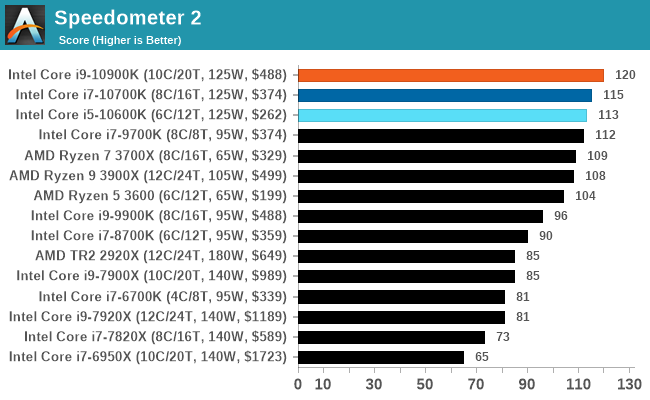
Google Octane 2.0: Core Web Compute
A popular web test for several years, but now no longer being updated, is Octane, developed by Google. Version 2.0 of the test performs the best part of two-dozen compute related tasks, such as regular expressions, cryptography, ray tracing, emulation, and Navier-Stokes physics calculations.
The test gives each sub-test a score and produces a geometric mean of the set as a final result. We run the full benchmark four times, and average the final results.
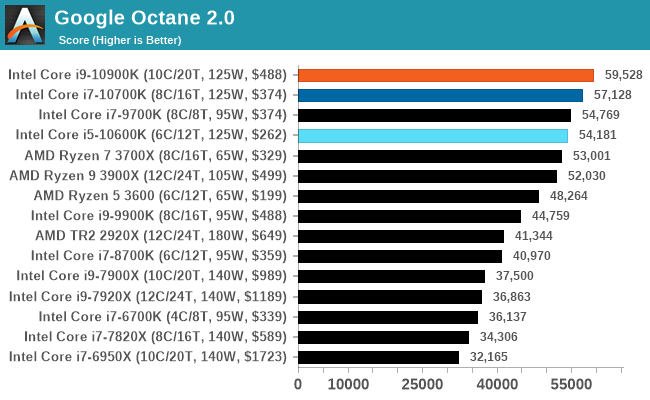
Mozilla Kraken 1.1: Core Web Compute
Even older than Octane is Kraken, this time developed by Mozilla. This is an older test that does similar computational mechanics, such as audio processing or image filtering. Kraken seems to produce a highly variable result depending on the browser version, as it is a test that is keenly optimized for.
The main benchmark runs through each of the sub-tests ten times and produces an average time to completion for each loop, given in milliseconds. We run the full benchmark four times and take an average of the time taken.
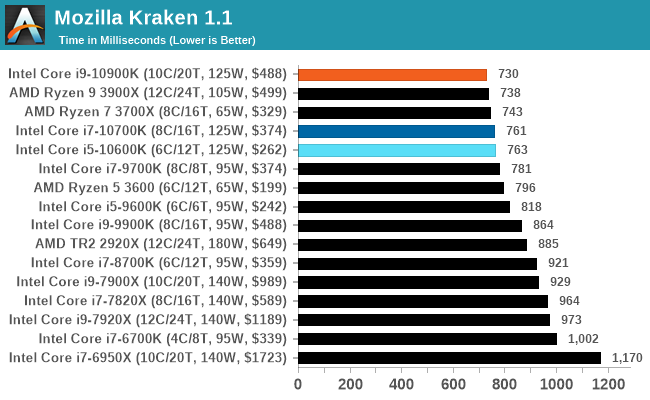
3DPM v1: Naïve Code Variant of 3DPM v2.1
The first legacy test in the suite is the first version of our 3DPM benchmark. This is the ultimate naïve version of the code, as if it was written by scientist with no knowledge of how computer hardware, compilers, or optimization works (which in fact, it was at the start). This represents a large body of scientific simulation out in the wild, where getting the answer is more important than it being fast (getting a result in 4 days is acceptable if it’s correct, rather than sending someone away for a year to learn to code and getting the result in 5 minutes).
In this version, the only real optimization was in the compiler flags (-O2, -fp:fast), compiling it in release mode, and enabling OpenMP in the main compute loops. The loops were not configured for function size, and one of the key slowdowns is false sharing in the cache. It also has long dependency chains based on the random number generation, which leads to relatively poor performance on specific compute microarchitectures.
3DPM v1 can be downloaded with our 3DPM v2 code here: 3DPMv2.1.rar (13.0 MB)
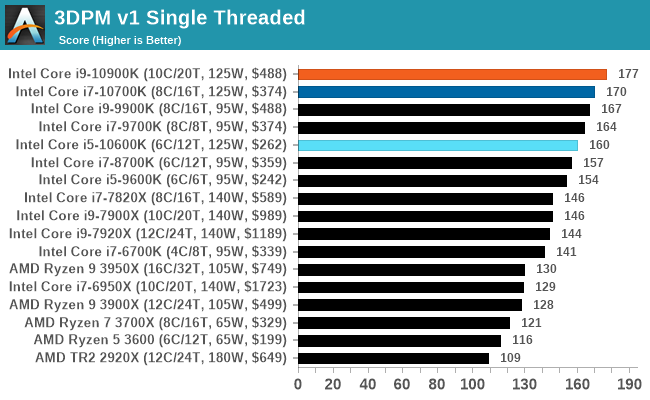
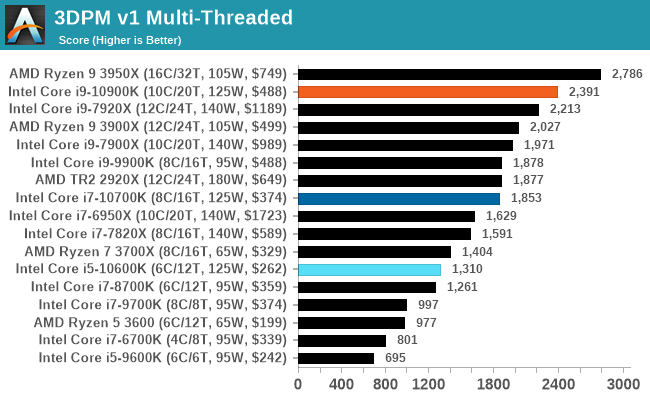
x264 HD 3.0: Older Transcode Test
This transcoding test is super old, and was used by Anand back in the day of Pentium 4 and Athlon II processors. Here a standardized 720p video is transcoded with a two-pass conversion, with the benchmark showing the frames-per-second of each pass. This benchmark is single-threaded, and between some micro-architectures we seem to actually hit an instructions-per-clock wall.
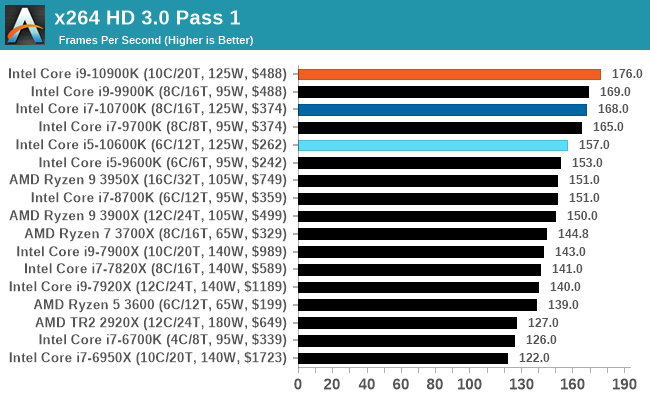
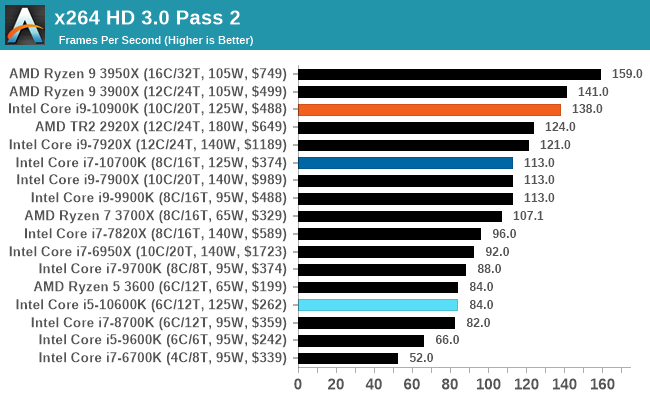










220 Comments
View All Comments
Boshum - Wednesday, May 20, 2020 - link
Pfft. You are hilarious.Spunjji - Tuesday, May 26, 2020 - link
Maxipad, the latest in the line of Gondalf imitators.Adm_SkyWalker - Wednesday, May 20, 2020 - link
Once again I find myself debating if I should upgrade. My current i7-6950X has held up better than I thought it would. I guess it's another year or two wait for me.Boshum - Wednesday, May 20, 2020 - link
I would be good with a beast like that for 5 more years.Icehawk - Saturday, May 23, 2020 - link
I’d wait until a component like mobo dies, that’s what got me to move from a 3770 about a year ago to a 8700 - mobo died and they were pricy and old. Replaced my wife’s i5 from same gen with a 3900X though recently and gave her the intel box. I’m a gamer but I do a lot of encoding so felt AMD offered a better mix and allows me to use my 450W fanless PSU. But aside from encoding speed I barely notice a difference from that 3700.Dug - Wednesday, May 20, 2020 - link
The problem with all these charts is that they are inconsistent.There are so many variables that aren't shown that it doesn't make sense to show these.
Most of this has to do with how motherboards handle the cpu's and what their default settings do.
There can be a 15% swing in AMD motherboard default settings between brands. Not to mention things like pbo on or off, infinity fabric, memory timings, etc.
I don't know about the Intel side. I remember their settings made less difference unless it was just cpu clock speed.
shady28 - Wednesday, May 20, 2020 - link
Agree with the sentiment, but you kinda stacked the deck with that last statement.Most of the Z490s are now supporting much higher speed RAM (up to DDR4-5000) and even intel 9th gen were good at overclocked RAM, while AMD systems rarely get above 3600Mhz. It shows if you look at something like PCMark 10 where the top 100 systems on almost all of the charts is completely dominated by intel. All of them are overclocked of course, but all of the top AMD systems are also overclocked.
What I would like to see is something along the lines of a i5-10600K vs AMD 3600 vs AMD 3600X, but not using 'all the same components other than mobo and CPU'. Take those 3 chips and build the fastest system you can with them. Use that PCI 4.0 NVMe and GPU on AMD, use that 4800Mhz CAS 18 RAM on the Intel. See what happens.
mrvco - Wednesday, May 20, 2020 - link
Ok, part of me would be curious to see what Intel could (or couldn't) do with an 11th Gen spin of their 14nm process.Findecanor - Wednesday, May 20, 2020 - link
The "Security" portion of this article is not really comprehensible. I can't guess what the author is thinking. The author needs to write it down in actual words what these things mean.Security on Intel processors is what is holding me off from buying any Intel CPU for the time being.
I consider myself pretty knowledgeable about the actual vulnerabilities themselves, and how they work, and how they can be mitigated -- in theory --, but if I have not kept up with every little tidbit of news about security on Intel's processors in particular, that portion of the article tells me absolutely NOTHING.
quadibloc - Wednesday, May 20, 2020 - link
These chips are impressive, and for people with a need to build a system today, and a preference for Intel, they are reasonably competitive. So I am favorably impressed, even if AMD would remain my own choice at the moment. I still do believe that in the long run, Intel does have the means to regain leadership, so that in a year or two or five, AMD will be back to being in second place (but in second place like the previous generations of Ryzens, not like the Bulldozer years). I don't know, though, if even Intel will be able to keep up at the process end; even it may have to go fabless after 10nm, which would have significant implications for the industry.